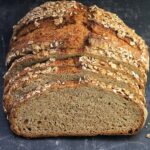
Light Rye Bread (no-knead, overnight recipe)
A tasty, nutritious loaf with a subtle tang of rye, plus the goodness of wholemeal wheat flour and lightness from white bread flour. A healthy everyday bread for sandwiches, toast, or to eat alongside soups and salad.
For more rye flavour, just replace some of the wholemeal or white wheat flour with wholemeal rye. Or try my Dark Rye Bread.
Ingredients
- 200 g wholemeal rye flour plus extra for dusting
- 200 g wholemeal bread flour
- 200 g white bread flour
- 2 tsp salt
- 1.5 tsp instant dried yeast i.e. the kind that does not require activating before use
- 400 - 450 g/ml water
For the topping (see Recipe Notes for alternative if you don't have rye flakes)
- 1 egg white beaten with a splash of water
- 2 tbsp rye flakes
Instructions
The night before you want to bake the bread
-
In a large mixing bowl, stir together all the flours, the salt and the instant dried yeast.
-
Pour approximately 350 g/ml of the cold water into the mixing bowl and use a sturdy silicone spoon or spatula to start bringing the ingredients together.
Add more water as needed to form a wet but not sloppy dough (see image in blog post for how it should look), stirring well so there are no dry bits of flour.
-
Cover the dough and leave overnight or 12 - 14 hours.
Tip: If the room is warm, or if you'd like a longer rise for convenience or to allow more flavour to develop, you can put the dough in the fridge for up to 24 hours. Bring the dough back up to room temperature before proceeding with the recipe.
On the day of baking
-
The dough should have risen, spread out, and be very bubbly. If not, leave a little longer.
-
Lightly flour a work surface and scrape the dough onto it.
Fold the dough over itself several times until it comes together into a smooth, round ball. Add more flour if needed, but only just enough to prevent sticking to the work surface.
-
Generously flour a round proving basket: if you don't have one then line a bowl with a clean tea towel and dust well with flour.
Transfer the ball of dough to the basket or tea towel lined bowl, placing it so the rounded top is now underneath.
Cover and leave to prove in a warm place for approximately 30 - 45 minutes.
-
While it's proving, preheat your oven to its highest setting and put on the middle shelf a cast iron pot or Dutch oven with its lid on.
-
Check if the dough is ready to bake: gently insert a finger into the dough and see if the dough quickly or slowly springs back.
- If the dough springs back slowly, leaving an impression, then it's ready.
- If it springs back immediately and doesn't leave an impression then leave to prove for longer and check again.
-
When ready to bake, remove the pot from the oven and take off the lid.
Carefully flip the dough from its proving basket or bowl into the pot so that the rounded side that was underneath is now on top.
Add the rye flake topping (work quickly so the pot stays hot)
- Brush a layer of beaten egg white over the top of the dough.
- Use a sharp knife, razor blade or baker's lame to cut a cross or a single slash across the top of the dough.
- Sprinkle over the rye flakes then very gently press down to help them stick: try not to let any fall into the slash.
- Brush over another layer of egg white.
SEE RECIPE NOTES FOR ADDING A GLAZE INSTEAD OF RYE FLAKES
-
Put the lid on the pot and place in the oven.
Immediately turn the heat down to 240°C / 220° Fan / Gas 9 / 475° F.
Bake for 30 minutes without removing the lid.
-
After 30 minutes, reduce the heat to 220° C / 200° Fan / Gas 7 / 425°F.
Remove the pot from the oven, tip the bread out of it, then return the loaf to sit directly on the oven shelf.
Bake for a further 15 minutes or until the bread is cooked through: it should sound hollow when tapped underneath.
-
Place on a wire rack until completely cold before slicing.
Best eaten within 3-4 days or can be frozen.
Tip: slice before freezing so you can take out just as much as you need without wastage.
Recipe Notes
Instead of topping with rye flakes, you can brush over a paste of rye flour and water to give a lightly glazed finish:
- Over moderate heat, whisk together 5 grams of rye flour and 25 grams/ml of water. Keep whisking until it boils and thickens. Take off the heat and leave to cool. Whisk in enough cold water to get a consistency like single cream.
- When you've flipped the proved dough into the hot pot, brush on a layer of the paste, slash the dough then put on the lid and transfer to the oven.
- As per the recipe, bake the bread for 30 minutes then turn out of the pot. Brush over another layer of the paste then put back in the oven and continue with the recipe.